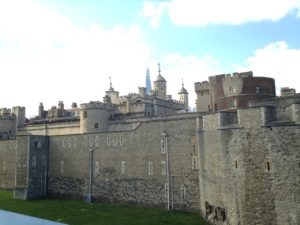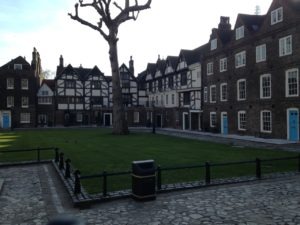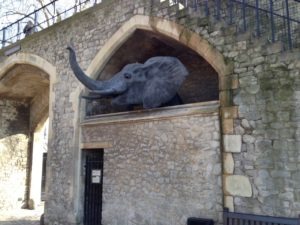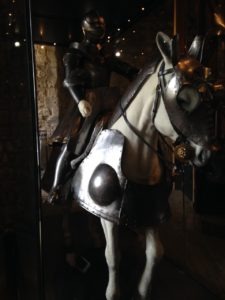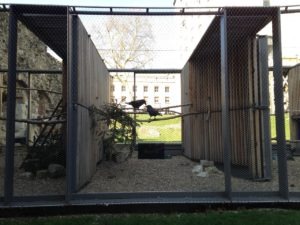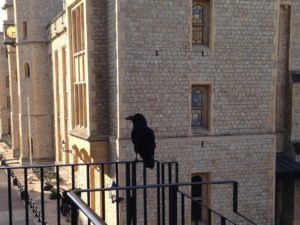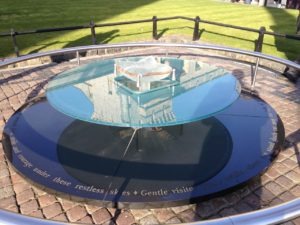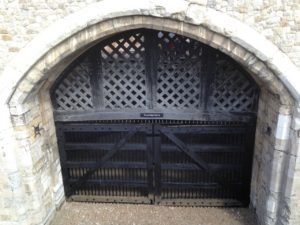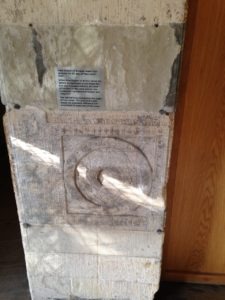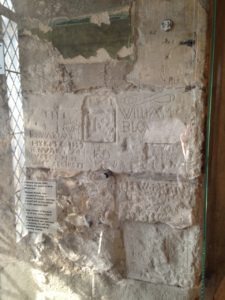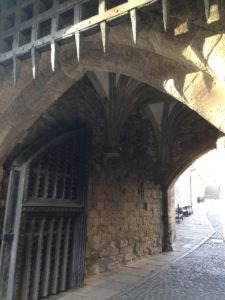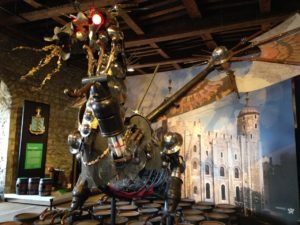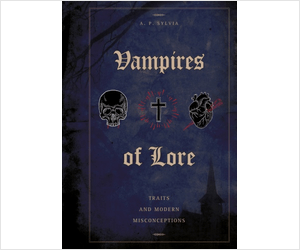Many legends can be found within the formidable walls of the Tower of London. Given the castle’s long and sometimes bloody history, it’s certainly no surprise. The prophetic ravens that live at the Tower are well known to the public, and ghost stories are certainly to be expected. However, while I was walking the ramparts there, I came across a piece of history that I found particularly interesting. An extremely intricate design of mystical nature was carved into the wall of one of the tower rooms. This centuries-old graffiti was the work of a prisoner once held there. What was the accusation against him? Sorcery.
Background
The Tower of London dates to the 12th century when William the Conqueror built a stone fortification in London to secure his control over the city. In the center of the fortress, a large and imposing keep was constructed. At the time, it would have loomed over London and sent a powerful message to the city’s inhabitants about William’s might and authority. This keep became known as the “White Tower” after it was painted that color by King Henry III in 1240. The overall castle structure was expanded upon in the 13th – 14th century.
Over its many years, the Tower has served a variety of purposes beyond military defense. It has been used as a royal residence, the royal mint, armory, zoo, and prison. The crown jewels are still kept there and are normally on public display. The Yeoman Warders, who are responsible for guarding the castle and giving tours, actually live onsite. The Tower has certainly evolved over time and has become a world-famous tourist attraction, visited by millions of people a year.
Famous Legends
One of the most well known legends about the Tower involves its feathered residents – the ravens. As the story goes, in the 17th century, the royal astronomer asked King Charles II to have the wild ravens removed from the Tower, as they were getting in the way of his observations. Before the King could grant the request, he was informed of a prophecy that essentially said, if the ravens ever left, the Tower would fall, as would the Kingdom. Charles II then decreed that six ravens must be kept on the grounds at all times. These days, seven ravens are cared for at the castle (one more than Charles’ decree, just to be safe). Visitors can see them freely roaming the grounds, and can also view their enclosures.
Various spirits are also said to haunt the Tower of London, many of them royal. The headless ghost of Anne Boleyn (Queen to King Henry VIII) has been seen near her execution site on Tower Green. The ghost of Lady Jane Grey (who reigned as queen for nine days) is believed to appear on the anniversary of her execution. Two small apparitions are thought to be the ghosts of Prince Edward and Prince Richard – who suspiciously disappeared in the late 15th century while being held captive in the Tower by their uncle, who had seized power. Of course, these are a just of handful of ghosts thought to inhabit the Tower. There are many more stories to explore for those who are curious. There’s even a tale of a ghostly bear!
Accused Sorcerer
With so many tales and legends surrounding the Tower of London, one can be spoiled for choice on what to write about. In this post, I wanted to share a piece of history that perhaps doesn’t get as much attention. It reflects how the laws of the past incorporated a belief in the supernatural.
Upon walking into the Salt Tower, which is one of the towers that comprise the castle, I was confronted by centuries old graffiti carved into the stone walls. Some of it was done by Jesuit priests. These men were imprisoned there in the 16th century for refusing to follow Henry VIII’s break from the Roman Catholic Church. Already in this room, one could see how religious belief could be a legal matter.
However, one of the carvings that caught my eye wasn’t done by a priest. It is extremely intricate, consisting of spheres, lines, astrological symbols, and grids. At the top of the carving is inscribed: “Hew Draper of Brystow made thys spheer the 30 daye of Maye anno 1561.” Apparently, the chart was intended to illustrate the influence of the planets on the hours and days of the week.
Hew Draper was a well-respected tavern owner in Bristol. On March 21, 1560, he was imprisoned in the Tower on suspicion of being a “conjurer” or “sorcerer.” An astronomer named John Man had accused Draper of casting spells against Sir William St. Loe and his wife, Elizabeth. Draper admitted that he had practiced magic in the past but had renounced it and burned his books. He denied taking such actions against Sir William and Lady St. Loe.
The fate of Hew Draper is unknown. On May 26, 1561, the lieutenant of the Tower had reported that Draper was very sick. Some have wondered if the position of the carving, being close to the floor, indicates that Draper was having issues standing due to illness. However, others think that it may have just been a more convenient place for comfort, light, or perhaps secrecy.
The act of carving this astrological chart has been interpreted by some as an act of bold defiance. It may have been that Draper was displaying his forbidden occult knowledge. However, others point out that astrology in-and-of-itself was acceptable during the Elizabethan era that followed Henry’s reign. Whatever Draper’s motive, the fact that the law allowed him to be imprisoned for magical assaults is something that lies in stark contrast to our modern era. It is a testament to people’s belief in the realities of the supernatural. I also find it interesting that his accuser was an astronomer. What were this astronomer’s views on astrology?
Conclusion
Unlike the malicious magic that people accused Draper of, the Tower of London has a sorcery all its own. It captivates the mind with its rich history, atmosphere, and legends. A visit there really is like walking back in time. The Tower is open to the public with paid admission. There is no onsite parking, though there is paid parking nearby. It is also accessible via public transportation. You’ll want to check the official website for prices, current exhibits, etc. (Please note, as of writing this, not all parts of the complex are open due to the pandemic.) I immensely enjoyed visiting the Tower when I was in London. Who wouldn’t enjoy exploring a haunted castle?
Location
Tower of London
London, EC3N 4AB
Official website: hrp.org.uk/tower-of-london/
Sources
Bayley, John. The History and Antiquities of the Tower of London: With Memoirs of Royal and Distinguished Persons. United Kingdom: Cadell, 1825. Page 210. https://www.google.com/books/edition/The_History_and_Antiquities_of_the_Tower/79lSAAAAcAAJ.
Clarke, Jay. “It’s Ghost Stories Galore at the Tower of London.” Chicago Tribune. March 12, 2000. https://www.chicagotribune.com/news/ct-xpm-2000-03-12-0003120391-story.html.
“Hew Draper panel.” LASSCO. Accessed October 3, 2020. https://www.lassco.co.uk/the-hew-draper-bronze-graffito-tablet-55713.
Jarus, Owen. “Tower of London: Facts & History.” Live Science. January 24, 2014. https://www.livescience.com/42821-tower-of-london.html.
Johnson, Ben. “Tower Ravens.” Historic UK. Accessed October 3, 2020. https://www.historic-uk.com/HistoryMagazine/DestinationsUK/Tower-Ravens/.
Jones, Jonathan. “‘Sorcerer’ Hew Draper’s Tower of London graffiti: a black art indeed.” The Guardian. April 13, 2020. https://www.theguardian.com/artanddesign/jonathanjonesblog/2010/apr/12/hew-draper-tower-of-london-graffiti.
Jones, Richard. “The Ghosts of the Tower of London.” London Walking Tours. Accessed October 3, 2020. https://www.london-walking-tours.co.uk/free-tours/tower-of-london-ghosts.htm.
“The Salt Tower.” English Monarchs. Accessed October 3, 2020. http://www.englishmonarchs.co.uk/tower_london_16.html.
“The story of the Tower of London.” Historic Royal Palaces. Accessed October 3, 2020. https://www.hrp.org.uk/tower-of-london/history-and-stories/the-story-of-the-tower-of-london/.
“Tower of London Ravens | Honored Members of the Royal Family.” Free Tours by Foot. Accessed October 3, 2020. https://freetoursbyfoot.com/tower-of-london-ravens/.
Written by A. P. Sylvia

